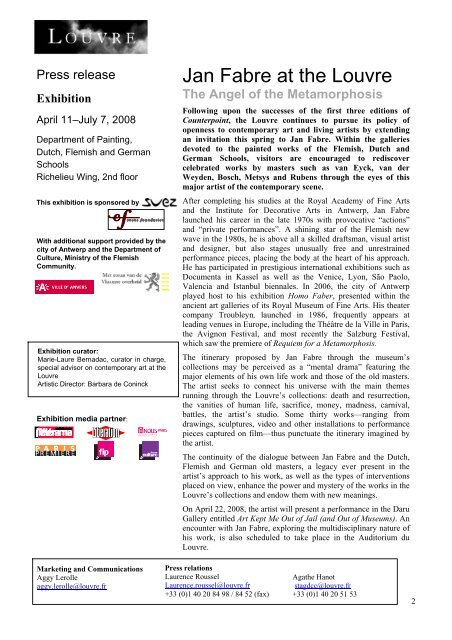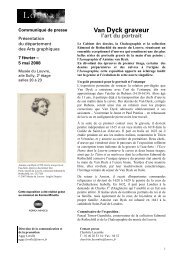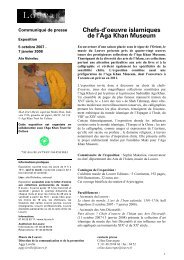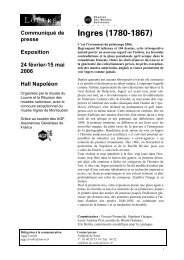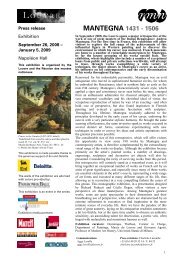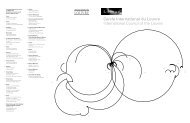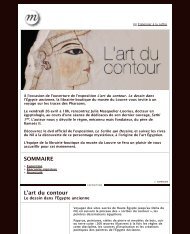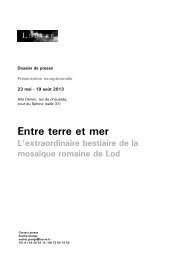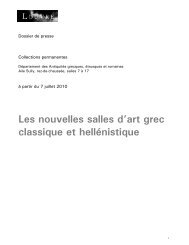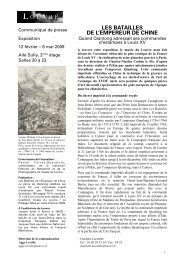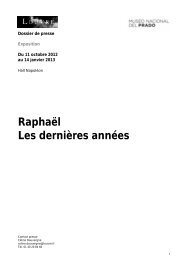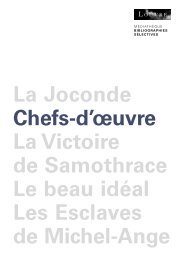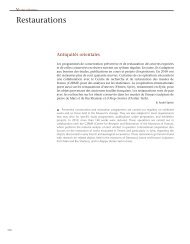The Angel of the Metamorphosis - Musée du Louvre
The Angel of the Metamorphosis - Musée du Louvre
The Angel of the Metamorphosis - Musée du Louvre
You also want an ePaper? Increase the reach of your titles
YUMPU automatically turns print PDFs into web optimized ePapers that Google loves.
Press release<br />
Exhibition<br />
April 11–July 7, 2008<br />
Department <strong>of</strong> Painting,<br />
Dutch, Flemish and German<br />
Schools<br />
Richelieu Wing, 2nd floor<br />
This exhibition is sponsored by<br />
With additional support provided by <strong>the</strong><br />
city <strong>of</strong> Antwerp and <strong>the</strong> Department <strong>of</strong><br />
Culture, Ministry <strong>of</strong> <strong>the</strong> Flemish<br />
Community.<br />
Exhibition curator:<br />
Marie-Laure Bernadac, curator in charge,<br />
special advisor on contemporary art at <strong>the</strong><br />
<strong>Louvre</strong><br />
Artistic Director: Barbara de Coninck<br />
Exhibition media partner:<br />
Marketing and Communications<br />
Aggy Lerolle<br />
aggy.lerolle@louvre.fr<br />
Jan Fabre at <strong>the</strong> <strong>Louvre</strong><br />
<strong>The</strong> <strong>Angel</strong> <strong>of</strong> <strong>the</strong> <strong>Metamorphosis</strong><br />
Following upon <strong>the</strong> successes <strong>of</strong> <strong>the</strong> first three editions <strong>of</strong><br />
Counterpoint, <strong>the</strong> <strong>Louvre</strong> continues to pursue its policy <strong>of</strong><br />
openness to contemporary art and living artists by extending<br />
an invitation this spring to Jan Fabre. Within <strong>the</strong> galleries<br />
devoted to <strong>the</strong> painted works <strong>of</strong> <strong>the</strong> Flemish, Dutch and<br />
German Schools, visitors are encouraged to rediscover<br />
celebrated works by masters such as van Eyck, van der<br />
Weyden, Bosch, Metsys and Rubens through <strong>the</strong> eyes <strong>of</strong> this<br />
major artist <strong>of</strong> <strong>the</strong> contemporary scene.<br />
After completing his studies at <strong>the</strong> Royal Academy <strong>of</strong> Fine Arts<br />
and <strong>the</strong> Institute for Decorative Arts in Antwerp, Jan Fabre<br />
launched his career in <strong>the</strong> late 1970s with provocative “actions”<br />
and “private performances”. A shining star <strong>of</strong> <strong>the</strong> Flemish new<br />
wave in <strong>the</strong> 1980s, he is above all a skilled draftsman, visual artist<br />
and designer, but also stages unusually free and unrestrained<br />
performance pieces, placing <strong>the</strong> body at <strong>the</strong> heart <strong>of</strong> his approach.<br />
He has participated in prestigious international exhibitions such as<br />
Documenta in Kassel as well as <strong>the</strong> Venice, Lyon, São Paolo,<br />
Valencia and Istanbul biennales. In 2006, <strong>the</strong> city <strong>of</strong> Antwerp<br />
played host to his exhibition Homo Faber, presented within <strong>the</strong><br />
ancient art galleries <strong>of</strong> its Royal Museum <strong>of</strong> Fine Arts. His <strong>the</strong>ater<br />
company Troubleyn, launched in 1986, frequently appears at<br />
leading venues in Europe, including <strong>the</strong> Théâtre de la Ville in Paris,<br />
<strong>the</strong> Avignon Festival, and most recently <strong>the</strong> Salzburg Festival,<br />
which saw <strong>the</strong> premiere <strong>of</strong> Requiem for a <strong>Metamorphosis</strong>.<br />
<strong>The</strong> itinerary proposed by Jan Fabre through <strong>the</strong> museum’s<br />
collections may be perceived as a “mental drama” featuring <strong>the</strong><br />
major elements <strong>of</strong> his own life work and those <strong>of</strong> <strong>the</strong> old masters.<br />
<strong>The</strong> artist seeks to connect his universe with <strong>the</strong> main <strong>the</strong>mes<br />
running through <strong>the</strong> <strong>Louvre</strong>’s collections: death and resurrection,<br />
<strong>the</strong> vanities <strong>of</strong> human life, sacrifice, money, madness, carnival,<br />
battles, <strong>the</strong> artist’s studio. Some thirty works—ranging from<br />
drawings, sculptures, video and o<strong>the</strong>r installations to performance<br />
pieces captured on film—thus punctuate <strong>the</strong> itinerary imagined by<br />
<strong>the</strong> artist.<br />
<strong>The</strong> continuity <strong>of</strong> <strong>the</strong> dialogue between Jan Fabre and <strong>the</strong> Dutch,<br />
Flemish and German old masters, a legacy ever present in <strong>the</strong><br />
artist’s approach to his work, as well as <strong>the</strong> types <strong>of</strong> interventions<br />
placed on view, enhance <strong>the</strong> power and mystery <strong>of</strong> <strong>the</strong> works in <strong>the</strong><br />
<strong>Louvre</strong>’s collections and endow <strong>the</strong>m with new meanings.<br />
On April 22, 2008, <strong>the</strong> artist will present a performance in <strong>the</strong> Daru<br />
Gallery entitled Art Kept Me Out <strong>of</strong> Jail (and Out <strong>of</strong> Museums). An<br />
encounter with Jan Fabre, exploring <strong>the</strong> multidisciplinary nature <strong>of</strong><br />
his work, is also sche<strong>du</strong>led to take place in <strong>the</strong> Auditorium <strong>du</strong><br />
<strong>Louvre</strong>.<br />
Press relations<br />
Laurence Roussel<br />
Laurence.roussel@louvre.fr<br />
+33 (0)1 40 20 84 98 / 84 52 (fax)<br />
Aga<strong>the</strong> Hanot<br />
stagdcc@louvre.fr<br />
+33 (0)1 40 20 51 53<br />
2
Jan Fabre I Let Myself Drain<br />
Homo Faber, 2006, Royal Museum <strong>of</strong><br />
Fine Arts, Antwerp.<br />
© <strong>Angel</strong>os/Attilio Maranzano<br />
© adagp, 2007<br />
Jan van Eyck, Diptych<br />
Department <strong>of</strong> Painting, <strong>Musée</strong> <strong>du</strong><br />
<strong>Louvre</strong><br />
Jan Fabre, Sanguis Sum,<br />
Homo Faber, 2006, Royal Museum <strong>of</strong> Fine Arts,<br />
Antwerp.<br />
© <strong>Angel</strong>os/Attilio Maranzano<br />
© adagp, 2007<br />
<strong>The</strong> Martyrdom <strong>of</strong> Art<br />
<strong>The</strong> paintings by Dutch, Flemish and German old masters in <strong>the</strong><br />
<strong>Louvre</strong> hold great fascination and are a source <strong>of</strong> both inspiration and<br />
considerable torment for Jan Fabre. I Let Myself Drain is <strong>the</strong> opening<br />
piece <strong>of</strong> this exhibition. <strong>The</strong> visitor, confronted with <strong>the</strong> artist’s alter<br />
ego, immediately enters his universe. <strong>The</strong> artist presents himself as a<br />
martyr, defeated by <strong>the</strong> talent <strong>of</strong> his predecessors and sacrificed in <strong>the</strong><br />
name <strong>of</strong> art.<br />
Drawings using <strong>the</strong> artist’s own blood (My Body, My Blood, My<br />
Landscape) mirror <strong>the</strong> brutal carnage <strong>of</strong> <strong>the</strong> Martyrdom <strong>of</strong> Saint<br />
Denis, <strong>the</strong> altarpiece by Henri Bellechose. In this practice, Jan Fabre<br />
rediscovers <strong>the</strong> violence and pain on view in many French and<br />
Flemish paintings, especially those arising from <strong>the</strong> Devotio Moderna<br />
movement.<br />
Death and Resurrection<br />
After martyrdom comes death. A recumbent figure depicting <strong>the</strong> artist<br />
in death, Sarc<strong>of</strong>ago Conditus, is presented at <strong>the</strong> center <strong>of</strong> room 5,<br />
opposite works by Hans Memling. For Jan Fabre, this entire room<br />
pays tribute to death and resurrection by virtue <strong>of</strong> <strong>the</strong> paintings<br />
displayed.<br />
Next, he conceives <strong>of</strong> <strong>the</strong> corridor dedicated to <strong>the</strong> panels by Justus <strong>of</strong><br />
Ghent as a passage between two worlds, illustrated by a series <strong>of</strong> Bic<br />
ball point pen drawings, <strong>the</strong> Blue Hour, on <strong>the</strong> <strong>the</strong>me <strong>of</strong><br />
metamorphosis.<br />
Moving on to <strong>the</strong> motif <strong>of</strong> <strong>the</strong> lamb, <strong>the</strong> quintessential sacrificial<br />
animal, with a reference to <strong>the</strong> Mystical Lamb, a Flemish treasure by<br />
Hubert and Jan van Eyck, Jan Fabre calls on <strong>the</strong> divine and <strong>the</strong><br />
spiritual in his work Sanguis Sum. At <strong>the</strong> same time, <strong>the</strong> party hat<br />
worn by <strong>the</strong> lamb recalls <strong>the</strong> carnival tradition <strong>of</strong> <strong>the</strong> Low Countries<br />
and gives a more prosaic dimension to this resurrection, raising <strong>the</strong><br />
question <strong>of</strong> <strong>the</strong> identity <strong>of</strong> <strong>the</strong> contemporary world’s savior.<br />
<strong>The</strong> Warrior <strong>of</strong> Beauty<br />
Of all <strong>the</strong> works in <strong>the</strong> galleries <strong>of</strong> German paintings, one in<br />
particular captures <strong>the</strong> attention <strong>of</strong> Jan Fabre, Hans Bal<strong>du</strong>ng Grien’s<br />
<strong>The</strong> Knight, <strong>the</strong> Young Girl and Death. This painting inspired <strong>the</strong><br />
artist to hang his three Pantser in <strong>the</strong> same room, works in armor<br />
made <strong>of</strong> scarab beetle shells. <strong>The</strong> artist also chooses to screen his film<br />
Lancelot in this same room, where <strong>the</strong> emblematic figure <strong>of</strong> <strong>the</strong><br />
“Knight <strong>of</strong> Despair” battling a lost cause becomes a fight against an<br />
invisible enemy or against himself.<br />
<strong>The</strong> <strong>the</strong>me <strong>of</strong> <strong>the</strong> warrior, central to <strong>the</strong> work <strong>of</strong> Jan Fabre, is found<br />
first in room 17 with <strong>the</strong> sculpture Will He Always Have His Feet<br />
Toge<strong>the</strong>r? <strong>The</strong> archetype <strong>of</strong> <strong>the</strong> warrior angel shares space with<br />
canvases by Rubens. In room 19, <strong>the</strong> installation Virgin/Warrior –<br />
Warrior/Virgin, which originated in a performance by <strong>the</strong> artist in<br />
collaboration with Marina Abramovic, presents, through <strong>the</strong> figures<br />
<strong>of</strong> <strong>the</strong> Virgin and <strong>the</strong> Warrior, a number <strong>of</strong> variations on <strong>the</strong> <strong>the</strong>mes<br />
<strong>of</strong> <strong>the</strong> cult <strong>of</strong> beauty, combat, sacrifice and forgiveness.
Portrait <strong>of</strong> Maria de’ Medicis,<br />
Frans II Pourbus,<br />
Department <strong>of</strong> Painting, <strong>Musée</strong> <strong>du</strong> <strong>Louvre</strong><br />
Jan Fabre, <strong>The</strong> Dung-Beetle<br />
Homo Faber, 2006, Royal Museum <strong>of</strong> Fine<br />
Arts, Antwerp.<br />
© <strong>Angel</strong>os/Attilio Maranzano<br />
© adagp, 2007<br />
Jan Fabre, Beheaded Messengers <strong>of</strong><br />
Death<br />
Homo Faber, 2006, Royal Museum <strong>of</strong><br />
Fine Arts, Antwerp.<br />
© <strong>Angel</strong>os/Attilio Maranzano ©<br />
adagp, 2007<br />
<strong>The</strong> Vanities <strong>of</strong> Human Life<br />
In <strong>the</strong> following rooms, <strong>the</strong> itinerary takes up <strong>the</strong> <strong>the</strong>me <strong>of</strong> <strong>the</strong><br />
vanities <strong>of</strong> human life, frequently represented in still lifes. <strong>The</strong><br />
two appendages <strong>of</strong> Umbraculum resonate with <strong>the</strong> skeletal<br />
remains on view in <strong>the</strong> altarpiece by Joos van Cleve and <strong>the</strong><br />
Diptych <strong>of</strong> Jean Carrondelet. <strong>The</strong>y suggest a model <strong>of</strong> humanity<br />
and spirituality removed from <strong>the</strong> physicality <strong>of</strong> <strong>the</strong> body and<br />
freed <strong>of</strong> original wounds.<br />
On ei<strong>the</strong>r side <strong>of</strong> Marinus van Reymerswaele’s Tax Collectors,<br />
Jan Fabre presents his drawings on bank notes entitled Money<br />
Collages. <strong>The</strong> next stop in <strong>the</strong> itinerary is an exploration <strong>of</strong> play<br />
and madness built around <strong>the</strong> Ship <strong>of</strong> Fools by Bosch and <strong>the</strong><br />
Fortune Teller by Lucas van Leyden with <strong>the</strong> Self-Portrait as<br />
Joker and drawings on playing cards by Jan Fabre.<br />
As <strong>the</strong> conclusion to this section, Jan Fabre presents two works<br />
that complement each o<strong>the</strong>r: his film <strong>The</strong> Problem, with <strong>the</strong><br />
participation <strong>of</strong> German philosophers Peter Sloterdijk and<br />
Dietmar Kamper, and his installation <strong>The</strong> Dung-Beetle. <strong>The</strong><br />
sphere made <strong>of</strong> scarab wing sheaths positioned on <strong>the</strong> mattress is<br />
<strong>of</strong> <strong>the</strong> same shape as <strong>the</strong> orb rolled along by each <strong>of</strong> <strong>the</strong> men in<br />
<strong>The</strong> Problem and also recalls <strong>the</strong> pearls ornamenting <strong>the</strong> queen’s<br />
gown in <strong>the</strong> painting by Frans Pourbus, <strong>the</strong> iridescent reflections<br />
<strong>of</strong> <strong>the</strong> scarab jewelry, <strong>the</strong> splendor <strong>of</strong> <strong>the</strong> fabric.<br />
Relics and Reliquaries<br />
With this section <strong>of</strong> <strong>the</strong> itinerary, Jan Fabre embarks on a new<br />
series, inspired by relics and reliquaries. Vermis Dorsualis &<br />
Devil Masks, respectively a spinal column and three gilt-covered<br />
human sacra, placed on a bed <strong>of</strong> powdered bones, are presented<br />
in a display case and allude to <strong>the</strong> preciosity <strong>of</strong> <strong>the</strong> finery worn<br />
by Hélène Fourment in <strong>the</strong> portrait by Rubens and <strong>the</strong> whiteness<br />
<strong>of</strong> her skin. Frans Snyders’ still lifes recall, as do <strong>the</strong> sacra<br />
resembling death masks, that death triumphs over all and over<br />
everyone and that it is inscribed in every living thing. This series<br />
reaches its stunning conclusion with Gravetomb, a contemporary<br />
rendering <strong>of</strong> <strong>the</strong> last judgment.<br />
<strong>The</strong> owls <strong>of</strong> <strong>the</strong> Beheaded Messengers <strong>of</strong> Death seem to be alive<br />
even though <strong>the</strong>y are stuffed. In <strong>the</strong> Flemish tradition, <strong>the</strong>se<br />
nocturnal birds are associated with madness as well as wisdom<br />
and <strong>the</strong>y <strong>of</strong>ten haunt <strong>the</strong> paintings <strong>of</strong> artists such as Bosch and<br />
Bruegel.<br />
Lastly, a new work created for <strong>the</strong> exhibition, made <strong>of</strong> wax<br />
appendages covered with glass eyes, Votive Offerings for<br />
Insomniacs, suggests <strong>the</strong> difficulty <strong>of</strong> falling asleep <strong>du</strong>e to <strong>the</strong><br />
se<strong>du</strong>ctions <strong>of</strong> <strong>the</strong> world <strong>of</strong> <strong>the</strong> senses, symbolized by <strong>the</strong><br />
numerous landscapes and portraits hanging in room 30.<br />
4
Jan Fabre Still Life with Artist<br />
Homo Faber, 2006, Royal Museum <strong>of</strong> Fine<br />
Arts, Antwerp.<br />
© <strong>Angel</strong>os/Attilio Maranzano<br />
© adagp, 2007<br />
On April 11: France Culture at <strong>the</strong> <strong>Louvre</strong><br />
for programs about Jan Fabre<br />
Visitor information<br />
Place<br />
<strong>The</strong> works are presented in <strong>the</strong> galleries <strong>of</strong><br />
<strong>the</strong> Department <strong>of</strong> Paintings, Dutch, Flemish<br />
and German Schools, Richelieu Wing<br />
Hours<br />
Open daily except Tuesdays and<br />
Thursdays from 9 a.m. to 5:30 p.m., and<br />
until 10:00 p.m. on Wednesdays and<br />
Fridays.<br />
Admission fees<br />
Access to <strong>the</strong> exhibition is included in <strong>the</strong><br />
purchase <strong>of</strong> an admission to <strong>the</strong> museum’s<br />
permanent collections: €9; €6 after 6 p.m.<br />
on Wednesdays and Fridays.<br />
Free admission for all visitors <strong>the</strong> first<br />
Sunday <strong>of</strong> each month, and for youths under<br />
26 on Fridays after 6 p.m. on Fridays. Free<br />
admission at all times for youths under 18.<br />
Fur<strong>the</strong>r information<br />
+33 (0)1 40 20 53 17<br />
www.louvre.fr<br />
<strong>The</strong> Artist’s Role<br />
Ushered in by <strong>the</strong> elephant tusk <strong>of</strong> Avant-Grade, <strong>the</strong><br />
purpose <strong>of</strong> this next stage in <strong>the</strong> itinerary is to sketch <strong>the</strong> life<br />
and role <strong>of</strong> <strong>the</strong> artist. Still Life with Artist, showing a<br />
peacock emerging from a c<strong>of</strong>fin, places emphasis on this<br />
creature’s vanity and <strong>the</strong> inescapable reality <strong>of</strong> death, which<br />
will catch it in full flight. This work is paired with <strong>the</strong> small<br />
painted portraits by Gérard Dou, especially <strong>the</strong> Self-Portrait<br />
presented in room 35. <strong>The</strong> Working Table/Bed, which takes<br />
up residence beneath <strong>the</strong> Arcadian Landscape <strong>of</strong> Johannes<br />
Glauber harmonizes with its color scheme, making it both<br />
<strong>the</strong> dreamed landscape <strong>of</strong> <strong>the</strong> artist at rest and his source <strong>of</strong><br />
inspiration. All <strong>of</strong> <strong>the</strong>se works are interconnected by <strong>the</strong><br />
series <strong>of</strong> drawings Sperm <strong>of</strong> <strong>the</strong> Parakeet, where appearance<br />
(birth and creation) and disappearance (death and sleep) are<br />
symbolized by semen.<br />
In room 39, Only Acts <strong>of</strong> Poetic Terrorism closes <strong>the</strong><br />
exploration <strong>of</strong> <strong>the</strong> role <strong>of</strong> <strong>the</strong> artist, calling attention to <strong>the</strong><br />
latter’s poetic activist mission.<br />
<strong>The</strong> itinerary ends with a monumental work pro<strong>du</strong>ced<br />
especially for <strong>the</strong> museum paying tribute to <strong>the</strong> renowned<br />
cycle <strong>of</strong> Marie de’ Medici portraits painted by Rubens.<br />
Gérard Dou, Self-Portrait<br />
Department <strong>of</strong> Paintings,<br />
<strong>Musée</strong> <strong>du</strong> <strong>Louvre</strong>
Related events and publications<br />
Publication: Catalogue <strong>of</strong> <strong>the</strong> exhibition Jan Fabre at <strong>the</strong> <strong>Louvre</strong><br />
Co-published by <strong>Musée</strong> <strong>du</strong> <strong>Louvre</strong> Éditions and Gallimard.<br />
Face to Face<br />
Auditorium <strong>du</strong> <strong>Louvre</strong><br />
Free admission subject to seating availability.<br />
Friday, April 25 from 6:30 p.m.<br />
At 6:30 p.m. Les Guerriers de la Beauté<br />
A film by Pierre Coulibeuf.<br />
France, 2002, 71 min, 35 mm.,color<br />
With Els Deceukelier, William Forsy<strong>the</strong>, Edmond Fabre, Jan Fabre, Emio Greco, Lisbeth Gruwez<br />
Screening followed by a discussion with Pierre Coulibeuf<br />
At 8:00 p.m. Dance and <strong>The</strong>ater from Jan Fabre<br />
Discussion between Jan Fabre, Jean-Marc Adolphe, Director <strong>of</strong> Movement publication, and<br />
Vincent Baudriller, co-director <strong>of</strong> Avignon festival<br />
Free admission subject to seating availability.<br />
Performance by Jan Fabre<br />
Daru Gallery and Cour Napoleon<br />
This performance is made possible thanks to <strong>the</strong> support <strong>of</strong> Louis Vuitton<br />
Tuesday, April 22 from 7:30 pm to 11:30 p.m.<br />
Art Kept Me Out <strong>of</strong> Jail (and Out <strong>of</strong> Museums)<br />
Jan Fabre conceives <strong>of</strong> his artistic practice as an organic continuum, a place <strong>of</strong> dialogue between<br />
<strong>the</strong> visual arts, <strong>the</strong> stage and <strong>the</strong> languages <strong>of</strong> <strong>the</strong> body. In honor <strong>of</strong> his exhibition at <strong>the</strong> <strong>Louvre</strong>,<br />
<strong>the</strong> artist presents a performance piece created especially for <strong>the</strong> museum. He has chosen <strong>the</strong> Daru<br />
Gallery as <strong>the</strong> venue, dominated by <strong>the</strong> well-known Winged Victory <strong>of</strong> Samothrace at one end.<br />
<strong>The</strong> effigies <strong>of</strong> Roman dignitaries, sculpted sarcophagi and o<strong>the</strong>r antiquities <strong>of</strong> <strong>the</strong> Borghèse<br />
collection, placed within <strong>the</strong>ir historical context in this gallery, are recast as players in a poetic<br />
quest. Encompassing <strong>the</strong> <strong>the</strong>mes <strong>of</strong> death, disguise and metamorphosis, Jan Fabre invites visitors<br />
to share, over <strong>the</strong> course <strong>of</strong> a single evening, in a meditation on <strong>the</strong> relationship between living<br />
artists and <strong>the</strong> museum. <strong>The</strong> performance is to be retransmitted in <strong>the</strong> open-air setting <strong>of</strong> <strong>the</strong> Cour<br />
Napoleon, while <strong>the</strong> public will be allowed to step into <strong>the</strong> gallery from time to time <strong>du</strong>ring <strong>the</strong><br />
performance.<br />
Conference and screenings in <strong>the</strong> Auditorium <strong>du</strong> <strong>Louvre</strong><br />
Free admission subject to seating availability.<br />
Saturday, April 26 from 10 a.m. to 7 p.m.<br />
Jan Fabre: Drawing, Sculpture, Installation<br />
Films <strong>of</strong> performances<br />
With Jan Fabre, Lorenzo Benedetti et Jan Hoet, Giacinto Di Pietrantonio, Game C, Bergame,<br />
Marta Herford, Paul Huvenne, musée des Beaux-Arts d’Anvers, Roselee Goldberg, Performa,<br />
New York, Nicola Setari, philosophe et critique d’art, Eckhard Schneider, Kunsthaus Bregenz,<br />
Philippe Van Cauteren, SMAK, Gand et Marie-Laure Bernadac<br />
<strong>Musée</strong> <strong>du</strong> <strong>Louvre</strong>.<br />
A selection <strong>of</strong> films <strong>of</strong> performances by Jan Fabre, ranging from <strong>the</strong> short subjects pro<strong>du</strong>ced in<br />
<strong>the</strong> 1970s to <strong>the</strong> artist’s most recent projects, will be screened and discussed.<br />
Press relations: Auditorium<br />
Marcella Lista Caroline Sueur Coralie James<br />
Programming 01 40 20 54 51 01 40 20 54 44<br />
Marcella.lista@louvre.fr caroline.sueur@louvre.fr coralie.james@louvre.fr


